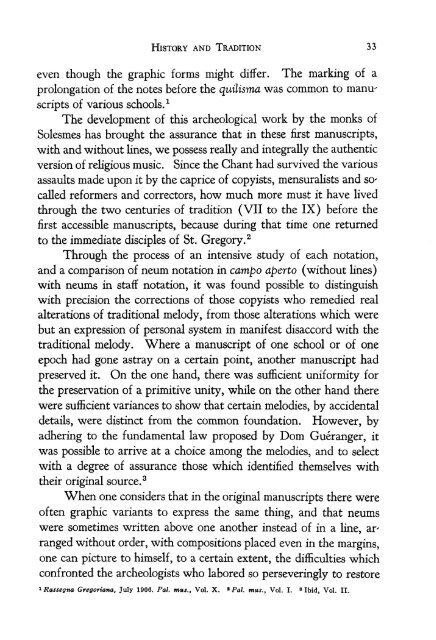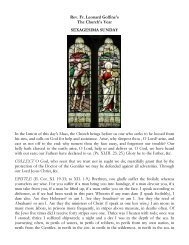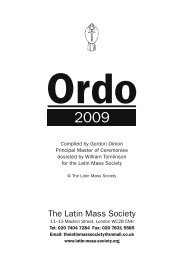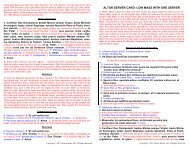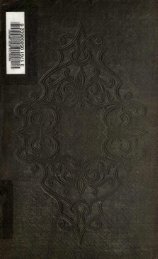The Spirit of Gregorian Chant - Church Music Association of America
The Spirit of Gregorian Chant - Church Music Association of America
The Spirit of Gregorian Chant - Church Music Association of America
Create successful ePaper yourself
Turn your PDF publications into a flip-book with our unique Google optimized e-Paper software.
HISTORY AND TRADITION 33<br />
even though the graphic forms might differ. <strong>The</strong> marking <strong>of</strong> a<br />
prolongation <strong>of</strong> the notes before the quilisma was common to manuscripts<br />
<strong>of</strong> various schools. 1<br />
<strong>The</strong> development <strong>of</strong> this archeological work by the monks <strong>of</strong><br />
Solesmes has brought the assurance that in these first manuscripts,<br />
with and without lines, we possess really and integrally the authentic<br />
version <strong>of</strong> religious music. Since the <strong>Chant</strong> had survived the various<br />
assaults made upon it by the caprice <strong>of</strong> copyists, mensuralists and socalled<br />
reformers and correctors, how much more must it have lived<br />
through the two centuries <strong>of</strong> tradition (VII to the IX) before the<br />
first accessible manuscripts, because during that time one returned<br />
to the immediate disciples <strong>of</strong> St. Gregory. 2<br />
Through the process <strong>of</strong> an intensive study <strong>of</strong> each notation,<br />
and a comparison <strong>of</strong> neum notation in campo aperto (without lines)<br />
with neums in staff notation, it was found possible to distinguish<br />
with precision the corrections <strong>of</strong> those copyists who remedied real<br />
alterations <strong>of</strong> traditional melody, from those alterations which were<br />
but an expression <strong>of</strong> personal system in manifest disaccord with the<br />
traditional melody. Where a manuscript <strong>of</strong> one school or <strong>of</strong> one<br />
epoch had gone astray on a certain point, another manuscript had<br />
preserved it. On the one hand, there was sufficient uniformity for<br />
the preservation <strong>of</strong> a primitive unity, while on the other hand there<br />
were sufficient variances to show that certain melodies, by accidental<br />
details, were distinct from the common foundation. However, by<br />
adhering to the fundamental law proposed by Dom Gueranger, it<br />
was possible to arrive at a choice among the melodies, and to select<br />
with a degree <strong>of</strong> assurance those which identified themselves with<br />
their original source. 3<br />
When one considers that in the original manuscripts there were<br />
<strong>of</strong>ten graphic variants to express the same thing, and that neums<br />
were sometimes written above one another instead <strong>of</strong> in a line, arranged<br />
without order, with compositions placed even in the margins,<br />
one can picture to himself, to a certain extent, the difficulties which<br />
confronted the archeologists who labored so perseveringly to restore<br />
i Rassegna <strong>Gregorian</strong>a, July 1906. Pal. mus,, Vol. X.<br />
2 Pal. mus., Vol. I. • Ibid, Vol. II.


